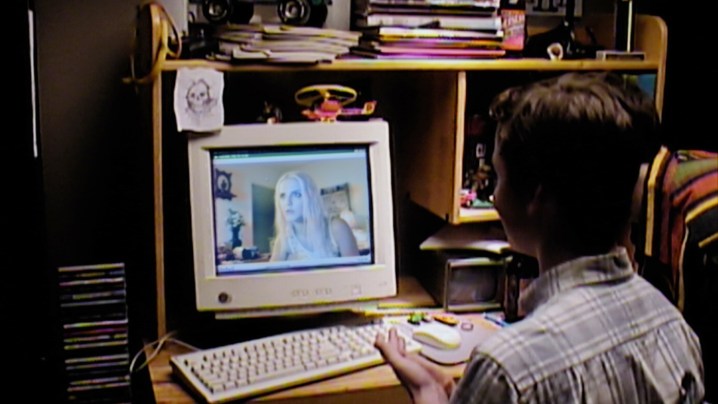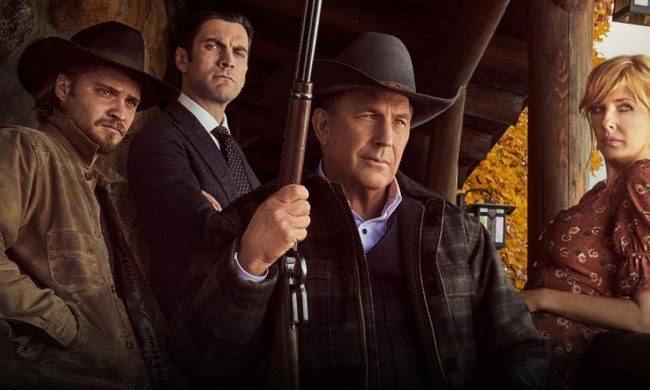“V/H/S/99 is a decent enough horror anthology that is ideal for casual viewing.”
- Decent scares
- Imaginative visuals
- Compact storytelling
- Uneven storytelling
- Some entries have bad special effects
- "Shredding" is terrible
Horror has a great tradition with the anthology format. From the 1945 British chiller Dead of Night to Tales from the Crypt in the ’70s to the Creepshow movies in the ’80s, the anthology format has been ideal for a variety of directors to present their horrific tales in bite-sized bits. After a brief period of uninspired entries, the subgenre came roaring back to life in 2012 with V/H/S, which utilized the found-footage style popularized by The Blair Witch Project to scare audiences and critics alike.
That tradition continues with the fifth and latest entry in the prolific series, V/H/S/99, which combines five disparate tales of mayhem and terror that are all united by being set in the same year (you guessed it, 1999). Like its predecessors — and pretty much any anthology ever made — there are good stories and bad ones, yet there’s just enough creativity, talent and, yes, scares to make V/H/S/99 worth your time.
Shredding

Unfortunately, the worst entry in V/H/S/99, Shredding, is the first one that opens the anthology, and it’s so awful you may be tempted to turn the whole thing off. Don’t. It’s a tale that asks “What if No Doubt was stalked and murdered by the ghosts of the metal band Kittie?” It follows four musicians who explore the mystery behind the gruesome deaths of another band at an abandoned music venue. Armed with a handy camcorder, and plenty of obnoxious personalities and attitude that would make them annoying in any era, these musicians soon find out it’s not a good thing to mock the tragic demise of their musical brethren.
Shredding doesn’t have any fresh ideas in it’s small head; the writer and director, Maggie Levin, just wants to show she can emulate what a late-’90s pop-rock band looked and sounded like, and contrasts it with what a mid-’90s heavy metal band looked and sounded like. The horror is almost an afterthought, as Levin literally throws anything against the wall, including fake-looking limbs and barely visible viscera, to see if it works. It doesn’t, and you’re left wondering why this story exists in the first place. It’s not scary, it’s not fun, and it doesn’t add anything to the anthology. A static screen would’ve been better (and as Poltergeist showcased so well four decades ago, scarier).
Suicide Bid

The next entry, Suicide Bid, is better, but suffers from one of the fatal flaws that bogs down Shredding: uninteresting characters and some questionable practical effects. The story focuses on a female student willing to do anything to join the elite sorority at her college. Taking advantage of the pledge’s desperation, the sorority sisters subject her to a cruel test to join their ranks: last as long as possible while being buried alive in a coffin. To add to the atmosphere, there’s also an old legend about a ghost, some uninvited guests in the pledge’s subterranean nightmare, and a well-timed thunderstorm.
It’s hard to feel sympathy for any of the sorority sisters, and Suicide Bid doesn’t bother to break the stereotypes associated with them. Instead, the entry’s strengths lie in exploiting two fears that almost everyone shares: enclosed spaces and creepy-crawly spiders. The director, Johannes Roberts, exploits these fears brilliantly by placing his camera, and the audience, in the coffin with the frightened pledge, and making us feel all of her real-time terror. It’s an effective piece of filmmaking; you just wish it was in service of a better story.
Ozzy’s Dungeon

The middle entry, Ozzy’s Dungeon, isn’t very terrifying, but what it lacks in scares, it makes up for in sheer creativity and bananas storytelling. The story centers around the titular fictional children’s show Ozzy’s Dungeon, a bizarro version of the Nickelodeon kids show Legends of the Hidden Temple. When one of the kids injures herself, her family decides to get revenge on the uncaring host of the show.
If the story ended there, Ozzy’s Dungeon would’ve been an entertaining if straightforward horror short story. Yet the director, the musician known as Flying Lotus, has better and weirder things in mind and, without giving anything away, what starts out as a revenge fable turns into a Lovecraftian comedy with stop-motion monsters, melting faces, and a final shot that evokes the surrealism of David Lynch. This one isn’t for everyone, but if you’re keyed into its weirdness, you’ll enjoy it.
Gawkers

The penultimate entry, Gawkers, is the most successful of the bunch because it utilizes its short 20-minute runtime the best by telling a straightforward “be careful what you wish for” story. In an unnamed suburb, five teenage boys, their minds consumed with girls, American Pie, and Limp Bizkit, obsess over a pretty young female neighbor next door. They plot to install a webcam to spy on her, but get more than they bargain for when they view the footage.
It’s a simple story, but the director, Tyler MacIntire, has more on his mind than just a routine horror short film. Without getting too academic, Gawkers tackles the toxic male gaze at the turn of the 21st century and refracts it, bringing in an unexpected ancient antecedent to counter the new ways modern technology allows males to exploit women. Gawkers is also very funny, as it gets right, in all of his gruesome detail, the particular mannerisms, lingo, and tastes of the average American male in 1999, which is another kind of horror altogether.
To Hell and Back

The final entry in the anthology, To Hell and Back, takes the biggest swing in terms of scope and intention, as it takes viewers to another dimension: Hell. The story opens with two documentary filmmakers chronicling a basement séance to bring forth a demon from Hell to inhabit a young woman’s body on New Year’s Eve 1999. Things go awry, and the two filmmakers find themselves in literal Hell, desperate for a way out.
What’s most impressive about this entry is how the directors, Joseph and Vanessa Winter, convincingly bring to life the afterlife through effective use of shadow, camera angles, and impressive practical effects. The citizens of Hell are suitably grotesque, and there are a couple of demons that even gagged this jaded horror viewer. The ending has a great comic twist that can only be done in a short film format.
Worth some of your time (but skip the bad bits)
While it never reaches the heights of the original Creepshow, V/H/S/99 is, at least, better than some of its predecessors and good enough to dip in and out of when it streams on Shudder. Most of the short films featured have enough visual flourishes, wit, and genuine scares to qualify as good candidates to pass the time in a crowded spooky season full of Smiles and Barbarians.
Don’t be a glutton for punishment and instead skip Shredding. Forgive Suicide Bid for its shallow characters and enjoy its claustrophobic visuals. Embrace the insanity of Ozzy’s Dungeon and the monster freak-out ending of Gawkers. And relish To Hell and Back and its successful attempt at making escaping Hell seem both scary and funny at the same time.
V/H/S/99 is now streaming on Shudder.




